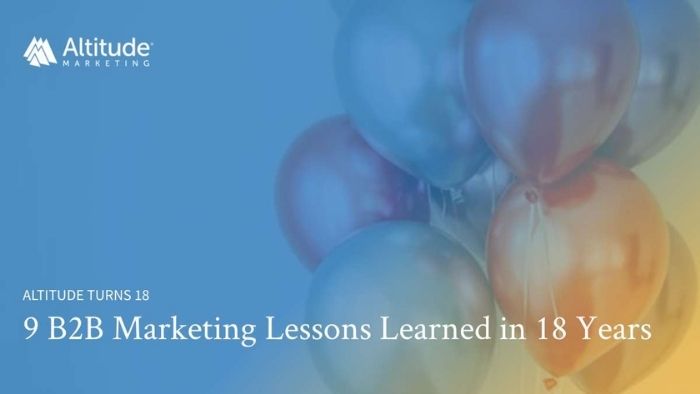We made it. Against most odds. Altitude is officially a young adult as we turn 18 this month.
Data from the Bureau of Labor Statistics shows that 45% of new businesses fail in the first five years. Only 25% of new businesses make it to 15 years old. I suspect those numbers are far worse for marketing agencies. It’s crazy to think when I set out on this adventure back in 2004 that I’d be where I am today: admiring strategic thinking, teamwork, hyper-creativity, technical acumen, data-driven decision making, brand building and lead generation efforts that our team of 30 or so does. For a global roster of B2B clients that stretches from Silicon Valley to Switzerland to Shanghai.
It hasn’t been easy to get here. Exhibit A: When I started Altitude, I didn’t have a single gray hair. Some may argue that is because I have real teenagers at home, but that is subject to debate in another post.
So how did we do it? Each year we take some hard knocks; usually three steps forward and 1.75 steps back. We assess every time we take a step back and grow stronger. Here are a few of the lessons I’ve learned over the past 18 years of leading and growing a global marketing agency – many of which can apply to just about any business.
Nine Leadership Lessons for B2B Companies
- Culture matters
- Stuff happens
- Always have 3 months of expenses in the bank
- Be transparent with the numbers
- Never have a client represent more than 15% of your revenue
- Be okay with never being the smartest one in the room
- Innovate or fall behind
- Focus
- Act authentically

Leadership Lesson #1: Culture matters
A lot. I used to think those posters that listed values, vision and mission on conference room walls at companies were a bunch of BS. Not anymore. The most important contributor to our success is a hyperfocus on fit. Team members need to buy in to who the company is – and aspires to be. Clients need to share similar values.
Over the years, we’ve built a culture that values teamwork over ego, work-life balance over squeezing every dollar in profit out of the company, integrity over win at any cost, a “can do” attitude vs a “we don’t do that” mindset, and employee empowerment to speak up and affect change instead of a top-down dictatorial system.
We look for clients that share similar values. Very early in our intro sales deck, we show our values and talk about our culture and the importance of fit. When a prospect loses interest here or tells us to skip that part, we move on. Not in the presentation. But we move on to a new prospect. Fit is critical in a high-performing client-agency relationship.
Leadership Lesson #2: Stuff happens
The CEO position is made to seem glamorous. It’s anything but. When asked if he wanted to be CEO of Twitter after amassing a 9.2% stake in the social media platform, Elon Musk said something along the lines of “Why would I want to be CEO? That job sucks.” I’ve learned to accept that being the boss means the worst problems du jour will find their way to my desk or inbox at some point – usually very late at night, early in the morning or at 4 pm on a Friday. That is what I am here for – to serve and backstop the team when things escalate. Learn to actively listen, take the heat, apologize early, listen some more and diffuse the situation as much as possible. Assure team members that mistakes happen, we’re all human in a human-centric business, and if your boss is going to fire you for one mistake, you have got the wrong boss.
Leadership Lesson #3: Always have 3 months of expenses in the bank
The traditional agency model is broken. Land a big new client. Hire a bunch of people. Lose a big client. Layoff a bunch of people. That does nothing to build a team willing to fight through tougher times. It does nothing to breed confidence in company leadership. It doesn’t help instill loyalty or enable a team to move from the forming stage to the norming stage to the high performing stage. By always having 3 months of expense in the bank, if we were to lose our top two clients, we have enough runway to replace those accounts, the dollars they represent, the families those dollars feed while steering clear of layoffs. Conversely, if we see a spike in growth on the horizon, we can confidently hire ahead of the demand.
We talk about the wins – who doesn’t – as much as we talk about the wobbly clients or processes that didn’t hold up to the stress test. This is a very transparent message to the team that I repeat often. And it gives confidence to the team that they don’t need to be looking over their shoulder when there is a client or two rumblings.
Leadership Lesson #4: Be transparent with the numbers
Every month, I share the monthly and YTD P&L, balance sheet, forecast and hurdles we face in the coming quarter and year. I learned this lesson long ago from Nancy Small, then publisher of the Organic Living group at Rodale. She taught me the importance of sharing the financials with the entire team. She believed as I do now, that when the team all knows where the organization stands financially, in both good and challenging times, it brings people together, gets them focused on a common cause and creates a sense of shared purpose and ownership.
Leadership Lesson #5: Never have a client represent more than 15% of your revenue
I’ve always preferred slow, steady growth over a saw tooth growth curve with massive hockey stick upswings and equally sharp drops. This ties in so nicely with #2-4 above. We’ve turned down opportunities that would have catapulted Altitude to the next level with rapidity. One such opportunity with a leading supplier of medical devices would have meant a 45% increase in business – and a 25% increase in staff – overnight. The chaos this would have created – on top of the normal chaos in an agency – could have been managed, but there would have been quite a bit of collateral damage in the form of employee burnout and potentially under-serving a non-squeaky wheel client. We said no to the opportunity – and still had a record year.
Leadership Lesson #6: Be OK not being the smartest one in the room
Check your ego at the door. Surround yourself with people that are smarter than you and turn them loose. A key part of my role now is to make sure we hire great people and get out of their way. If they buy into the culture and the goals, they will get it and make you look great for believing in them. If I ever find myself being the smartest one in the room, I either grab someone else or start discussions around the next strategic hire we need to make.
Leadership Lesson #7: Innovate or fall behind
I’m a big fan of repeatable processes. It brings consistency, form, shape, accountability, and much comfort to steady types. However, I’ve always said if we are doing what we are doing today, six months from now, we’ll be out of business in a year. Think about the changes in B2B marketing over the past 18 years. Our first websites were done in DreamWeaver. Marketing automation didn’t exist. SEO was in its infancy. Trade shows commanded 50+% of a B2B company’s marketing budget. LinkedIn was barely a year old and had less than one million members (today, it boasts 810 million members).
If the belief that we always have to be innovating was ever in doubt, just look at 2020. This was Altitude’s best year ever. Yes, the year we all got locked down, the economy shuttered and we were forced to go remote. We had to change how we did business. We had to be nimble and help our client pivot. We were forced to look at our processes and ask why and how we make this better, even more efficient, even more high-impact. We examined everything. And it paid off. 2021 beat 2020 as we carried those innovations forward – and continued to build on them.
Leadership Lesson #8: Focus
And then focus again. With very few exceptions, it’s hard to be everything to everyone. But most companies in their early years are trying to do just that. And while this may keep the cash flowing temporarily, it dilutes a company’s vision and primary focus – and can derail an otherwise solid business plan for years.
I had a check-in meeting with a start-up tech company that I advise. When I asked about how they were tracking the product roadmap timeline, they explained that things were delayed a few months as they took on several other development projects and had to redeploy some resources. This is chasing dollars – not building a business. You have to stay focused on what will get your company where you believe it can go. When we made the strategic decision to focus exclusively on B2B and adjust our own marketing and offerings to best serve this market, we had our first real spike in growth. A few years later, we narrowed down B2B companies in and around the life sciences, enterprise software and advanced manufacturing. You can picture the Venn diagram. Where they overlap is our sweet spot. And while we now pass on more than 50% of our inbound opportunities, we’ve been growing admirably ever since because of, not despite, this focus.
Leadership Lesson #9: Act ethically
Every day. I believe if you do right by your team, they, in turn, do right by the client. When you do right by the client, they renew and refer you to their colleagues, and the business grows. Whenever faced with a tough, ethical decision on what to do in a particular situation, I always ask myself if I could go home at the end of the day, feeling that I have made a decision that fosters a safe and joyful environment for my team, then I have made the right decision.
Here’s to the next 18 years!



